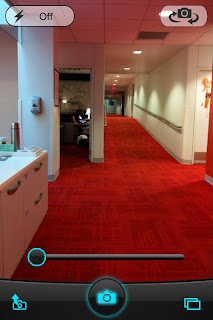.jpg)
Hipstamatic is my personal least favorite application, which is odd because as far as features for photography (NOT editing) go, versatile barely describes it. Part of the reason I’m so negative is because it takes a lot of getting used to, you really can’t jump into it and go. Also, it comes with a pretty bare shelf of features for the money you invested in the application’s purchase. How do I get more features, you ask? A dollar at a time, I say.
Open the app and it may take you a moment to orient yourself. You can click the flash to activate the camera’s “flash”, and it will make the charging noise and take a moment to get set (you can shoot while it charges, the charge is just for aesthetic appearance). The slat on the left will tell you what film you’re using, and you can view your pictures buy tapping on the bottom left.
To get into the meat of this thing, hit the arrow in the bottom right corner. If you’re a photographer, it’ll take you a moment to realize you’re in familiar territory. If you’re not, make sure you play with this application for several minutes to figure it out. You can select different films, and by tapping the film you can see the effect it will have. Same for flashes, and then for lenses. Want more choices? Go buy them, cause they don’t come free. On this screen, you can also change the quality of your pictures by adjusting the lever in the center of the main screen. Once you’ve mixed and matched to take the desired style of picture (good luck if you don’t have any training, here), go back to the camera taking screen and get after it.
Hipstamatic looks the best. It does. It’s got this old timey, film and dark room feel to it, and in theory having the ability to choose all the aspects of your picture taking process would be awesome. And if you know what you’re doing and have experience with these tools, then I would imagine it’s intriguing. But it’s just too complicated for a lot of journalists to take this into the field without any experience using it. You’re not going to get an image you can use for news, most likely, because all the “equipment” it comes with will cause all different tints. And even though it’s only a dollar each, to spend the money to figure out what does and does not work costs too much cash and time.
There are two details about this program I DID really like. Your photos can be grouped into “stacks” for easy organization. Not a big deal, but it’s often overlooked in photo programs, and it’s something that makes life easier. Second, Hipstamatic hosts contests, and you can submit your photos to these contests. Not something you would normally do while out in the field, but I’m sure photographers would enjoy the ability to submit their work. I can see this particular feature carrying this application, especially if photographers and Synthetic Corp. (makers of Hipstamatic) take it seriously.
Simply put, Hipstamatic is a cool idea, and has a lot to offer to the feature writers and artists of this world who know how to work a camera. If you don’t fit that criteria, steer clear.































.jpg)









.jpg)
.jpg)